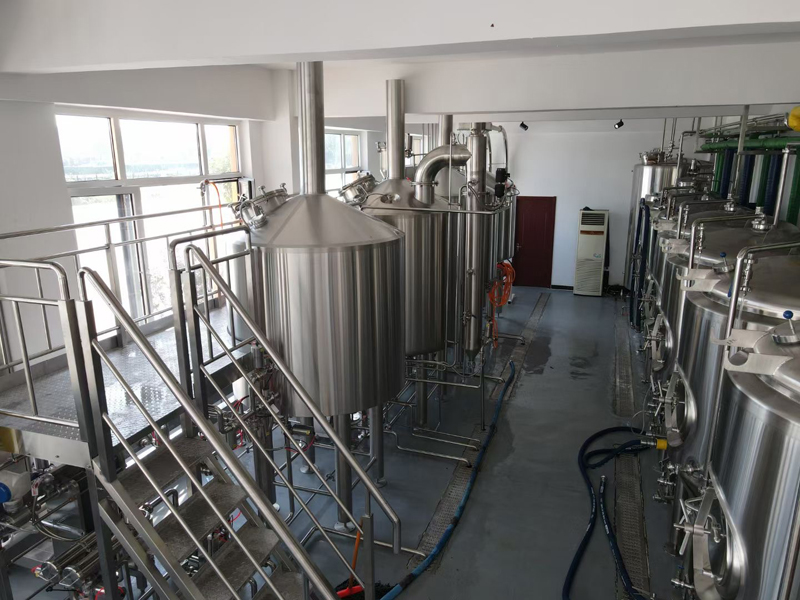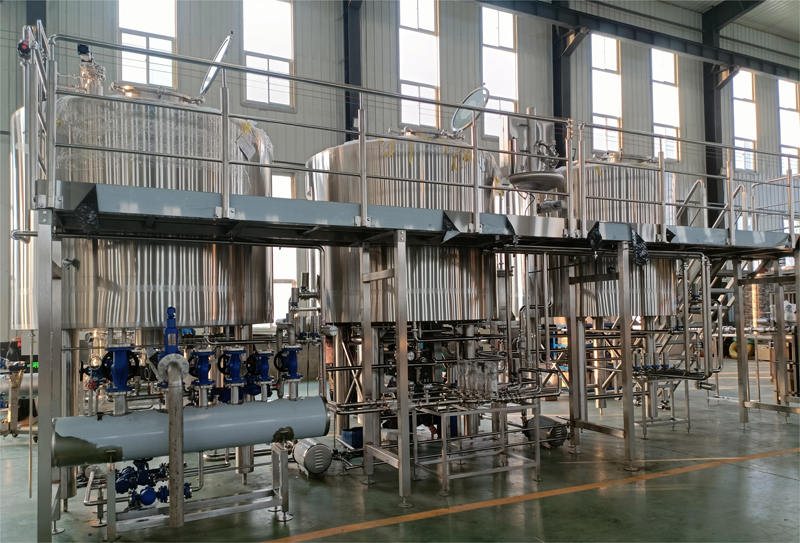What is a Commercial Automated Brewing System?
A commercial automated brewing system is a technologically advanced solution designed to simplify and optimize the brewing process on a commercial scale. While traditional brewing methods require a lot of manual labor and precision, these modern systems streamline the process using automation and sophisticated technology.
There are a few essential components of these systems:
Control Panel: This is the brain of the operation. With touch screen interfaces, brewers can easily adjust settings, control fermentation temperatures, and more.
Automated Mashing: Instead of manually adding grains, the system does it for you. This ensures consistency in every batch.
Temperature Control: Precise temperature control is crucial in brewing. Automated systems provide accurate temperature regulation throughout the process.
Historically, brewing was a meticulous and labor-intensive process. The introduction of automation in brewing has not only simplified the process but has also made it more consistent, ensuring that every batch of beer tastes the same.
One of the primary benefits of using an automated brewing system is the reduction in manual errors. For instance, over-boiling or incorrect temperatures can adversely affect the beer’s taste. With automation, these risks are significantly minimized.
The use of commercial automated brewing systems is now widespread among modern breweries, aiming to meet growing demand, ensure product consistency, and streamline their operations.

10HL automatic brewery
What are the Types of Commercial Automated Brewing Systems?
Commercial automated brewing systems have undergone tremendous advancement in recent years. As demand grows and technology evolves, manufacturers have introduced several types of systems to cater to varying brewery sizes and needs.
Microbrewery Systems: Designed for small-scale production, these systems typically have capacities ranging from 500 to 2000 liters. They are perfect for craft brewers who prioritize quality over quantity. While they’re smaller in scale, they still offer robust automation
Pub Brewery Systems: Made for pubs or restaurants that brew their beer on-site. They balance between small-scale craft production and the need for slightly larger volumes to serve direct customers.
Industrial Brewery Systems: These are for large-scale production, with capacities exceeding 10,000 liters. Major beer brands and large brewing facilities use these systems. They’re designed for efficiency and high-volume production.
R&D Brewery Systems: Research and development systems are for experimental batches. Breweries use them to test new recipes, ingredients, or brewing methods without committing to large-scale production.
Each system type has its unique features and pricing, but all aim to automate and simplify the brewing process. When selecting a system, it’s vital to consider the scale of production, available space, and specific brewing needs.
Functions of a Commercial Automated Brewing System
Commercial automated brewing systems have revolutionized the way beer is produced on a large scale. These systems are equipped with numerous functionalities designed to make the brewing process more efficient, consistent, and scalable.
Mashing: One of the most critical steps in brewing is mashing. The system automatically mixes the grains with water at the right temperature. This process extracts the sugars from the grains, which will later be fermented into alcohol.
Boiling: Post mashing, the liquid, known as wort, is boiled. Automated systems ensure that this boiling occurs at the precise temperature and duration required for the specific beer being produced.
Fermentation Monitoring: The fermentation process can be finicky. Too warm or too cold, and the entire batch can be ruined. Automated systems continuously monitor the fermentation tanks, adjusting the temperature as needed to ensure optimal yeast activity.
Cleaning and Sanitization: After brewing, the equipment needs thorough cleaning to prevent contamination of subsequent batches. Automated systems come with integrated cleaning protocols that ensure every part of the system is cleaned and sanitized efficiently.
Quality Control and Data Analytics: Advanced systems now integrate sensors that monitor various parameters during brewing. These data points are crucial for maintaining consistency across batches and for continuous improvement. Additionally, real-time data analytics can alert brewers to any issues immediately, allowing for swift interventions.
The automation of these functions not only ensures a higher quality of beer but also allows breweries to operate more efficiently, reducing wastage, and increasing profitability.

20HL brewhouse automatic system
How Can a Commercial Automated Brewing System Benefit You?
The introduction of commercial automated brewing systems into the beer-making industry has transformed the way breweries operate. From small craft breweries to large industrial setups, these systems offer a range of benefits that make brewing efficient, consistent, and profitable.
Efficiency Boost: One of the primary advantages of an automated brewing system is its efficiency. By automating many of the brewing process’s manual aspects, these systems can produce more beer in less time, optimizing production schedules and increasing the volume of saleable product.
Consistent Quality: In the brewing industry, consistency is crucial. Fans of a particular beer brand expect the same taste, aroma, and mouthfeel every time they crack open a bottle. Automated systems, with their precise control over ingredients, temperatures, and timings, ensure that every batch matches the previous one in terms of quality.
Resource Savings: Through precise measurements and control, automated systems can lead to savings in raw materials, energy, and water. This not only reduces costs but also minimizes waste, making the brewing process more sustainable.
Real-time Data Monitoring: Modern commercial automated brewing systems come equipped with various sensors and analytics tools. These tools provide brewers with real-time data about the brewing process, enabling them to make informed decisions and quickly address any issues that may arise.
Scalability: As a brewery grows, its production needs will change. Automated systems can be scaled up (or down) to match production demands. Whether it’s adding more fermentation tanks or integrating additional features, these systems can grow with the business.
Labor Savings: With automation handling many of the tasks previously done by hand, breweries can operate with fewer staff. This can lead to significant savings in labor costs. Furthermore, staff can be reallocated to other areas of the business, such as sales, marketing, or customer service.
Safety Enhancements: Brewing involves handling hot liquids, heavy equipment, and sometimes hazardous chemicals for cleaning and sanitization. Automated systems can reduce the risks associated with these tasks, ensuring a safer working environment.
How to Choose the Right Commercial Automated Brewing System?
Selecting the appropriate commercial automated brewing system is pivotal for any brewery, whether it’s a startup or an established entity looking to scale up or modernize. A well-chosen system can streamline operations, boost efficiency, and ensure consistent product quality. Here’s a comprehensive guide on how to make the right choice.
Assess Your Production Needs: Before diving into the world of brewing systems, a brewery must evaluate its production requirements. This involves considering current production volumes, future growth prospects, and the types of beers intended for production. Having clear data will provide direction during the system selection process.
Budget Considerations: Budget is always a crucial factor. The range in prices for commercial automated brewing systems is vast. Establish a clear budget, considering not just the system’s initial cost but also installation costs, potential future upgrades, and ongoing maintenance expenses.
Features and Capabilities: Different systems come with varied features. Some might offer advanced quality control mechanisms, while others might focus on energy efficiency. When assessing a system, make a list of essential features versus desirable ones.
Vendor Reputation: The reputation of the system manufacturer or vendor plays a significant role. Research vendors, check for reviews, ask for references, and, if possible, visit facilities where their systems are in operation.
Flexibility and Scalability: The brewing industry is dynamic. As a brewery grows or as market demands shift, the production needs might change. Choosing a system that’s both flexible and scalable ensures that it remains relevant and efficient in the long run.
After-sales Support and Training: The installation of a new system often requires training. Breweries should prioritize vendors that offer comprehensive training and robust after-sales support. This ensures that the system runs optimally and any issues are promptly addressed.
The selection process can be daunting, given the technicalities and the investment involved. However, by following a structured approach and focusing on the brewery’s unique needs and circumstances, it becomes significantly easier to pinpoint the system that will drive success.
Post time: Dec-25-2023

